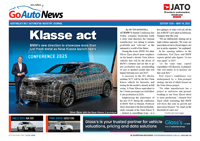News - General News - FuelsGas a hard sell, says HoldenMass resistance: Holden's Richard Marshall says most drivers remain to be convinced of the benefits of switching to LPG. Gas abundant, but still too many hurdles for drivers – including cheap petrol16 Jun 2009 By IAN PORTER AUSTRALIAN drivers will not switch from petrol and diesel to LPG (liquified petroleum gas) while the oil price is at relatively low levels, according to GM Holden. GM Holden energy and environment director Richard Marshall told a Melbourne seminar on gaseous fuels that a lack of progress by the gas industry with car buyers was down to three reasons: technology, infrastructure and customer acceptance. He said the industry had to offer the right technology if it was to win customers away from petrol. “Petrol and diesel have 100 years of development behind them,” he said at the seminar organised by the Society of Automotive Engineers (SAE). “While most of these alternate fuels have had a lot of work done, they still need a fair amount of work to achieve the same level of performance (driveability).” Mr Marshall said Australia had about 3000 LPG filling stations after 20 years of work, but infrastructure issues still lingered. “We still have the situation with, say, a fleet buyer where they might have a tie up with a service provider like Caltex, and that then might lock them out of a whole geographic region from being able to get fuel,” he said But the biggest problem was that the public was reluctant to make the move. “Customers typically are risk averse, and there is a lot of doubt in their minds before they jump,” Mr Marshall said. “You’ll always have the early adopters but, in the end, it has got to come to whether you have the right business case. “I really think while oil remains on a par, it will hold back the development of alternative fuels. A lot of the alternative fuels will languish while oil prices stay low.”  Left: Holden's dual-fuel Commodore V6. Below: Orbital Gas Products managing director Tony Fitzgerald. Left: Holden's dual-fuel Commodore V6. Below: Orbital Gas Products managing director Tony Fitzgerald.Speaking to GoAuto afterwards, Mr Marshall indicated Holden nonetheless was considering launching a dedicated LPG Commodore. At present Holden makes a dual-fuel (petrol and LPG) model. Mr Marshall said Holden was still working on alternative fuel system because it wanted to be ready when the oil price spiked again. “We are working on more alternative fuel technologies than we have ever done before,” he said. He confirmed that Holden would release an E85 Commodore in 2010 that could run on petrol only or a blend of up to 85 per cent ethanol, but he would not be drawn on when Holden would release its LPG-only model. He also refused to comment on specifics of a mild hybrid project with the Co-operative Research Centre for Advanced Automotive Technologies (AutoCRC). The AutoCRC prefers rear-wheel drive for a mild hybrid application as the driveshaft makes it simple and relatively cheap to add the electric motor’s torque to the drivetrain. That project draws on a lot of technology developed by the CSIRO and is a distant relation to the ECOmmodore, which was developed by Holden and the CSIRO and unveiled in 2000. “The AutoCRC is a separate thing and they can do what they like. There are various partners and we are one of them,” he said. “It’s just another of the technologies that is potentially out there. Like I said, we’re interested. We certainly support electric because we are going to bring the Volt out here. “We think there is significant long-term potential in electric vehicles. The Volt will be here in 2012, and after that we will just see how the market pans out.” Orbital Gas Products managing director Tony Fitzgerald told the seminar the reputation of LPG cars would rise in coming years as manufacturers took over from converters as the major suppliers of LPG cars in Australia. Last year, about 110,000 LPG vehicles rolled on to the roads, but only about 15,000 were from a car-maker. Ford’s E-Gas Falcon is the only dedicated LPG car made in Australia, but Holden also offers factory-fitted HSVi “aftermarket” dual-fuel LPG systems for its Commodore and Ute. Mr Fitzgerald said Orbital believed 175,000 cars would be sold in 2015 and that 80,000 would be factory-built. “A range of Australian and Korean makers will be offering LPG vehicles by then,” he said. Orbital is developing the LPG system for the next E-Gas Falcon and has decided to opt for a liquid-injection LPG system, as this gives better combustion than the old fumigator system. Mr Fitzgerald said the company was also developing a series of kits for aftermarket conversions of cars up to five years old. Orbital would do extensive calibration testing so that customers would not have to take their cars back to the converter for “final” adjustments and so that the converted car would have driveability equivalent to an unleaded petrol car. “The driveability needs to be absolutely seamless,” he said. The seminar was also told that the use of compressed natural gas (CNG) had made little headway in road transport because it placed too many hurdles in front of the customers wanting to use it. Rare Consulting managing director Mark McKenzie said that despite 20 years of effort, the promotion of CNG as a transport fuel was not working. He said Australia needed to start making the switch because projections showed that, by 2030, Australia would need to import 80 per cent of its oil needs as local fields were depleted and demand grew. Mr McKenzie said it was not simply a case of vehicle operators waiting for fuel distributors to invest in filling stations and operators of filling stations waiting for more CNG vehicles to hit the roads. “That’s the chicken and egg argument, and it’s irrelevant,” he said. He told the seminar the cost of adopting CNG was too high, even if the running costs were low. Changes in technology forced operators to depreciate their vehicles quickly, making them less profitable, and high oil prices made hybrid drivetrains more competitive. “CNG is not the only alternative technology.” But the biggest hurdle was the difficulty of switching from diesel to CNG, he said. “A normal fleet procurement takes about three months. The planning horizon for adopting CNG is more like 18 months to two years.” Customers had to organise the engine technology, their gas supply, the manufacture of gas tanks to fit their particular trucks and the aftermarket service and support. And, to top it off, the customer had to wear all the risk involved, Mr McKenzie said. The operators generally had to organise the service support away from base and, to top it off, customers were often used as guinea pigs by suppliers without being told. “The CNG market needs a whole new paradigm.” He said he was heartened at the Brisbane truck show to see four truck-makers release gas-powered models – a development that would make it easier to switch. Mr McKenzie also rejected claims that the federal government should do something to further promote the use of CNG as a transport fuel. He was previously the national facilitator for the environment and water resources departments’ alternative fuels conversion program, which had a budget of $80 million. He said only a fraction of that money was drawn down by truck operators to make the switch to gas. “There is a certain wariness in Canberra about the promotion of gas as a transport fuel,” he said. Read more:Brace for an energy shortageLPG interest spikes LPG grants to be phased out E-Gas Falcon set for fuel economy lift |
Click to shareGeneral News articlesResearch General News Motor industry news |














Facebook Twitter Instagram